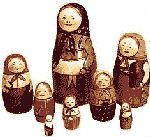 |
 |
Nested Niches
By : Jim Pinto, The automation majors, just a handful of multi-billion-dollar companies, are all combinations of medium-sized and small divisions. They are just like matryoshkas or Russian dolls, each nested within a larger group.
July 2010
|
 Industrial automation seems like a large, unified market, but it’s not; rather, it’s a loose conglomeration of diverse market segments and specialized applications.
Industrial automation seems like a large, unified market, but it’s not; rather, it’s a loose conglomeration of diverse market segments and specialized applications.
Industrial markets that automation companies serve include manufacturing (everything from automobiles to appliances, tennis-balls to toasters); petrochemical (production and pipelines); pharmaceuticals; electric and nuclear power; water and waste; food and beverage; paper and pulp; metals; mining—a long list of fragmented markets, each with special requirements, regulations, pricing and services. Smaller companies target narrow niches and geography, while larger suppliers serve broader markets with variations of standard products. Most automation majors have target-market teams as part of their overall marketing/sales focus. Automation products are all kinds of specialized gadgets and instruments—sensors, displays, recorders and actuators—and a wide variety of systems with a mixture of those products, plus software and services. There are very few requirements for high quantities of any particular product—hardly any millions of anything. Millions of products are used, but many are specialized variations related to particular industries and requirements. There are two major product segments for systems:
In this mix, the markets for industrial PC software expanded, initially as human-machine interface (HMI), with expansions for displays, data logging, historical analysis and the like. Although used across a broad array of market segments, the total available market for independent packaged software was limited. The large process controls suppliers acquired the leaders and expanded into related software arenas—manufacturing execution systems (MES) and the like. Beyond these middle products are the field devices—sensors (for measuring process variables such as temperature, pressure, flow, speed, position, load and pH) and actuators at the other end of the system (heaters, valves, motors, solenoids, positioners and so on) to control those same variables. Each of these has special requirements in different markets, relating to physical size, shape, operating temperatures and physical environment. Again, specialized niche companies cater to specific applications and requirements, while the majors supply a broader base over wider geographical territories. Diverse and confusingAll these different products are sold to these fragmented markets with sales and distribution channels that are equally diverse and confusing. Small companies have independent sales representatives and distributors who focus on exclusive geographic territories with several lines of complementary products. Larger companies tend to have more representatives and stocking distributors. Most automation majors try to integrate all of the above channels with their own sales people focusing on primary customers.Because automation is such a fragmented business, mid-sized "mini-conglomerates," such as Ametek, Roper Industries, Spectris and others, grow primarily through acquisition of small, innovative, niche product companies (typically $10 million to $20 million annual revenue) whose growth has been self-limited through lack of capital for new products and/or global sales expansion. The automation majors—just a handful of multi-billion-dollar companies—are all combinations of medium-sized and small divisions. They are just like matryoshkas or Russian dolls, each nested within a larger group, down to niche-related $10 million to $20 million and even smaller pieces—reflecting the market as a whole. 
|
 Pinto's Points How to win in the Automation Business Go shopping - books, electronics, CD/DVD Selected advertising coming here. Contact Jim Pinto for rates. |
Return to Index of all JimPinto Writings

 Return to JimPinto.com HomePage
Return to JimPinto.com HomePage
If you have ideas or suggestions to improve this site, contact: webmaster@jimpinto.com
Copyright 2006 : Jim Pinto, San Diego, CA, USA
